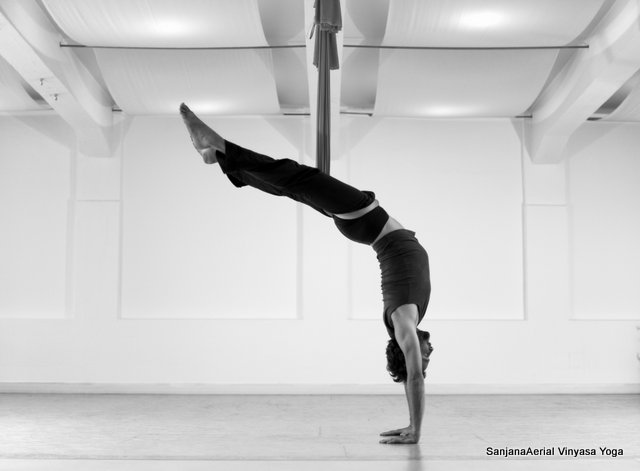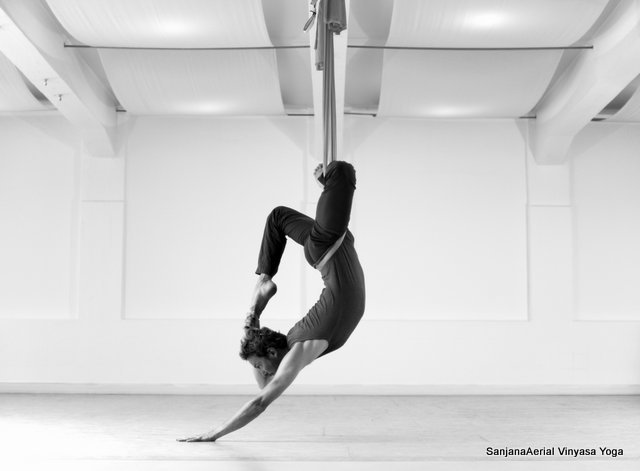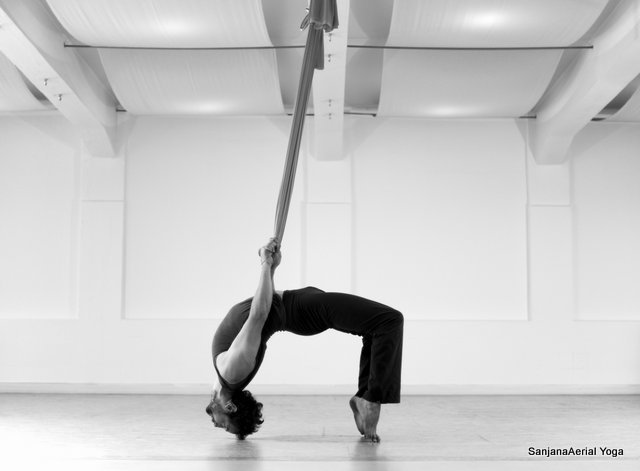 Aerial Arts & Yoga :
Aerial Arts & Yoga :
Aerial Arts have been around for a while, and Yoga has been around for a while longer.
When Aerial Arts and Yoga got to know each other, as it happens when communities of practicioners start to grow and overlap, it became quickly obvious that the poses practiced in yoga and aerial arts have many similarities.
Pretty much around the same time different Aerial Artists started teaching classes labeled aerial yoga, using the hammock as the aerial tool of choice, where typical yogaasana were included to emphasize the yoga part.
The hammock quickly showed its enormous potential to assist or deepen the typical yogaasana. It can invert (headstand, shoulderstand etc) practicioners who previously where unable to to so, and allows for a complete shift of effort in backbends. (not effortless, but very different efforts :) )
Aerial artists, who also became or were yoga teachers, a real interest in teaching the yoga part in aerial yoga emerged. The practice became more than a yoga look-a-like, but a wonderful tool to really enhance the practice of yogaasana.
Aerial Vinyasa Yoga :
One such teacher is Michelle Dortignac, founder of Unnata® Aerial Yoga, and surely many others.
Lucas happend upon Aerial Yoga out of curiosity, and without any previous practice of Aerial Arts joined a 2 part Teacher Training of Unnata® Aerial Yoga in early 2013 in Cyprus and Athens.
The technique and practice came rather easy to him, but the structure and system were not in complete agreement with his usual yogapractice.
The part which is commonly known as 'Vinyasa' was missing, which often gave hime a feeling of disbalance after a class, and could even lead to headaches. This was partly attributed to not understanding the techniques (yet) or to not being used to the practice (yet), but was later discovered to really come from the rhythmn (or lack thereof) and emphasis on single asana. Without a continuation of movement the practice felt disconnected.
In a Vinyasa Yoga class the elements and structures of how to move between poses, and what elements are brought from one asana into the next, matter more than the finished asana. The elements are the focus, and the connections between poses. Every breath and every move is the practice and deepens our awareness of the present moment.
The 'final' pose just happens as a continuation of the Vinyasa.
This is the part of yoga that Lucas could not be content without.
As a long term VinyasaYoga teacher (yogastudio since 2003) who newly learned aerial techniques, the purpose of how to use the hammock to enhance his practice of yoga clearly remained in the foreground.
So an Aerial Vinyasa Style started to emerge within a few months of having finished his first teacher training of Unnata® Aerial Yoga in 2013. Two years later the structure and understanding became clear enough for a teacher training and workshops to be developed.
Only in 2016 came the realization that this practice actually had quite grown into a distinct style of Aerial Yoga. The name Sanjana finally emerged in 2017, which is a direct translation of the most important element that the style represents : The connection between the ground, us and the hammock, the connection of breath to movement & vice ver ca as well as the connection and transfer of fundamental elements of alignment between poses.


